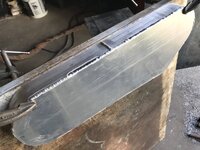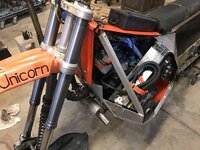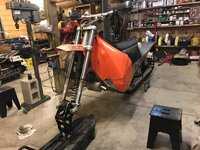Install the app
How to install the app on iOS
Follow along with the video below to see how to install our site as a web app on your home screen.
Note: This feature may not be available in some browsers.
You are using an out of date browser. It may not display this or other websites correctly.
You should upgrade or use an alternative browser.
You should upgrade or use an alternative browser.
Polaris RMK 800 snowbike
- Thread starter Brett Kobernik
- Start date
Agreed. I'm a little surprised the Hawk wasn't more popular. I thought they were an awesome innovation when they came out. I was in no position to purchase one at the time but would have if I had the funds. That said, I'm really excited about my builds. I'm hoping my Yamalaris proves to be even better than the Unicorn.So Awesome!!! So much of this represents, in my opinion, the future of mountain snowmobiling. The "going skinny" trend isn't going away any time soon.
Then it's crazy to think how the Hawk was rejected because it was here 30 years too early.
I'm starting on the shrouding. This is progressing easier than I anticipated. The biggest challenge is building a cover for the primary clutch. I haven't quite decided how I'll do it. My thinking is that it needs to be quite sturdy to protect the clutch from stumps, logs, and rocks lurking under the snow. Also, it'll need to be able to protect the clutch when the bike tips on it's side. It also needs to be "snow tight" so it doesn't allow snow to get inside and make the belt slip. I have a few ideas. We'll see what transpires.

The other criteria for the clutch cover is that I need to be able to get a belt on and off easily. I pretty much screwed around for an entire day until I came up with a solution. First, I welded on some flat bar to the frame that I can use to secure the cover.

Next, I fabricated a skid plate.
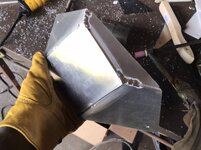
I can TIG weld aluminum...........barely. This should protect the clutch enough. I’ll use plastic to cover everything.


Next, I fabricated a skid plate.

I can TIG weld aluminum...........barely. This should protect the clutch enough. I’ll use plastic to cover everything.

Pegs between the clutch and the drive shaft or a very short set of boards?
Sent from my LG-H873 using Tapatalk
Sent from my LG-H873 using Tapatalk
Footpegs are going to be mounted about 10" behind the driveshaft. Right about where the suspension pivot shaft is bolted through the tunnel. This is about the same foot position as the original RMK.Pegs between the clutch and the drive shaft or a very short set of boards?
Sent from my LG-H873 using Tapatalk
Been working with the TIG welder trying to finish all the aluminum welding. Got the motor mounts stuck together.

I welded up an oil reservoir.

Because of the shape I had to use for the reservoir, I’ll need to add a sump off the front so the oil pump doesn’t starve on steep hill climbs.

I routed the coolant lines.

Everything is looking pretty clean. I have a good amount of room for the airbox which I’ll tackle soon.

I finished up both skid plates to protect the primary and the stator.


I welded up an oil reservoir.

Because of the shape I had to use for the reservoir, I’ll need to add a sump off the front so the oil pump doesn’t starve on steep hill climbs.

I routed the coolant lines.

Everything is looking pretty clean. I have a good amount of room for the airbox which I’ll tackle soon.

I finished up both skid plates to protect the primary and the stator.

Agreed. I'm a little surprised the Hawk wasn't more popular. I thought they were an awesome innovation when they came out. I was in no position to purchase one at the time but would have if I had the funds. That said, I'm really excited about my builds. I'm hoping my Yamalaris proves to be even better than the Unicorn.
The Hawk was just too far ahead of it's time. It was too early to get the benefits of more modern sleds like lighter tracks, lighter chassis, fuel injection, etc. It would have been much more liked with these modern improvements.
Awesome build man! Following along with interest
Great build......reminds me of the Snow Hawks we used to ride. The HO600 Snow Hawk was a ripper with the Rotax 600 engine.
Keep posting!
Keep posting!
Good progress on the front end today. I’m using a first generation Timbersled spindle because, well, it was free. They work fine. I’m not really a fan of using clamps around the bottom of the fork tubes. I’ve destroyed a number of spindles over the years after hitting rocks. Friends have done the same. I learned inadvertently that using a piece of aluminum mounted to the fork and then using two 5/16” soft bolts to secure the spindle to the aluminum is better. The soft bolts act as shear pins and will shear if you hit something hard enough. The spindle and fork tubes are less likely to get damaged.

The first gen spindle needs modifying to accommodate a third shock though. Pretty easy. I just cut two slots, perforate the aluminum between and break it off.

Now the third shock fits. I’m using a Z-bros Trident prototype.

Couple pieces of angle aluminum for the top bracket under the fender.
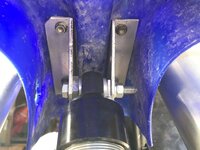
Here’s a look at the other side. I welded up a steel bracket that bolts to the pinch bolts and fork guard mount. I haven’t used this method before. I’m hoping it’ll be adequate. One thing that I’ve noticed about running the third shock is that it appears to absorb a bunch of shock when clobbering a rock or stump unexpectedly. Because the third shock is attached near the pivot on the ski, it takes up some of the force rather than all of the force getting transferred through to the spindle mounts. Not that it won’t happen again but I haven’t destroyed a spindle since running the third shock.


The first gen spindle needs modifying to accommodate a third shock though. Pretty easy. I just cut two slots, perforate the aluminum between and break it off.

Now the third shock fits. I’m using a Z-bros Trident prototype.

Couple pieces of angle aluminum for the top bracket under the fender.

Here’s a look at the other side. I welded up a steel bracket that bolts to the pinch bolts and fork guard mount. I haven’t used this method before. I’m hoping it’ll be adequate. One thing that I’ve noticed about running the third shock is that it appears to absorb a bunch of shock when clobbering a rock or stump unexpectedly. Because the third shock is attached near the pivot on the ski, it takes up some of the force rather than all of the force getting transferred through to the spindle mounts. Not that it won’t happen again but I haven’t destroyed a spindle since running the third shock.

Worked on the chain case today. I built a mount that holds an idler sprocket. The mount rotates a small amount to adjust the chain tension.

There were a few things to consider with this chain tensioner. First, it needed to be stronger than others I’ve built since it will need to hold tension when the machine is in reverse. (YES!! A snowbike with reverse! Unloading from the pickup is going to be sooooooooo nice and easy!) I built a stopper that holds the mount in place.
The second consideration is ease of adjustment. The whole procedure can be done with one wrench.
I’m using a Vortex RX3 530 chain. The thing is mean. 11,000 lb tensile strength. I got tired of wearing chains out on my old machines. This thing took care of that. WAY longer wear life. I hope it will hold up to the 800cc 2-stroke.
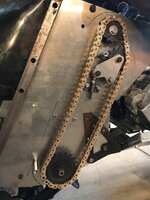
I’m using coupling nuts (seen in photo above) to secure to cover. I only have two in place. I’ll add at least one more, probably two more.


There were a few things to consider with this chain tensioner. First, it needed to be stronger than others I’ve built since it will need to hold tension when the machine is in reverse. (YES!! A snowbike with reverse! Unloading from the pickup is going to be sooooooooo nice and easy!) I built a stopper that holds the mount in place.
The second consideration is ease of adjustment. The whole procedure can be done with one wrench.
I’m using a Vortex RX3 530 chain. The thing is mean. 11,000 lb tensile strength. I got tired of wearing chains out on my old machines. This thing took care of that. WAY longer wear life. I hope it will hold up to the 800cc 2-stroke.

I’m using coupling nuts (seen in photo above) to secure to cover. I only have two in place. I’ll add at least one more, probably two more.

I ran reverse gear last season on the stock riot chain adjust roller and still had the s curve/slider on the main chain. I didn't think it would hold up but it did. The single bolt never slipped. I got to thinking every time you grab the brake it pulls on the slack side pretty hard too in sticky snow.
When I built my first couple of snow bikes I fabricated chain case covers almost exactly as you show, basicly water tite.........not good. I soon found out a dry chain in a cover is a hot chain and chains wore out quick. As soon as I built covers just to keep our pants out off the chain and let lots of snow process through the chains case, really never even put slack in a chain in a years riding. My new RIOT last year got chain case ventilation before the first ride.
Nice work, I really like to see the throw out the "norm" and start building something.
Nice work, I really like to see the throw out the "norm" and start building something.
Hmmmm, good observation. It's something that I hadn't considered in the past but that I'll be looking at when I put this thing on snow next month.When I built my first couple of snow bikes I fabricated chain case covers almost exactly as you show, basicly water tite.........not good. I soon found out a dry chain in a cover is a hot chain and chains wore out quick.
Got any pics of how you "vented" your chaincase cover? I assume this would be a good idea on an ARO as well.When I built my first couple of snow bikes I fabricated chain case covers almost exactly as you show, basicly water tite.........not good. I soon found out a dry chain in a cover is a hot chain and chains wore out quick. As soon as I built covers just to keep our pants out off the chain and let lots of snow process through the chains case, really never even put slack in a chain in a years riding. My new RIOT last year got chain case ventilation before the first ride.
Nice work, I really like to see the throw out the "norm" and start building something.
Similar threads
R
- Replies
- 0
- Views
- 998
R
- Replies
- 1
- Views
- 3K
- Replies
- 18
- Views
- 7K
D
- Replies
- 4
- Views
- 3K
D





